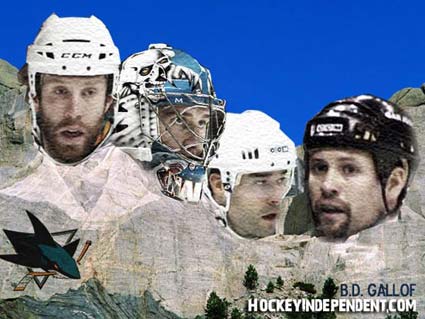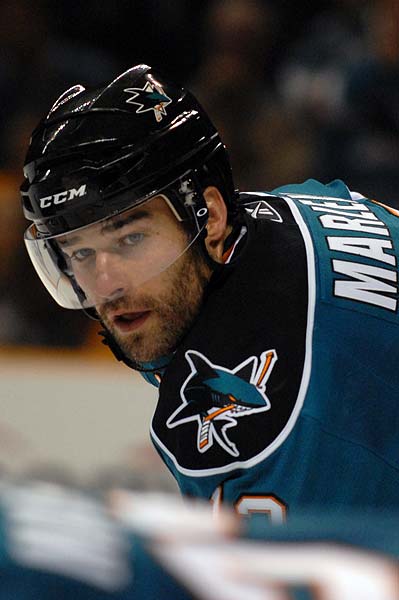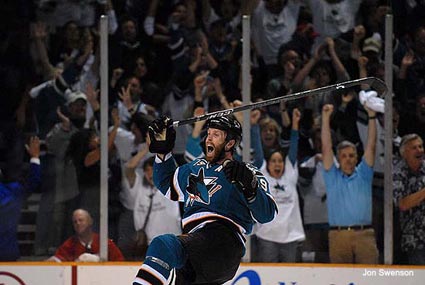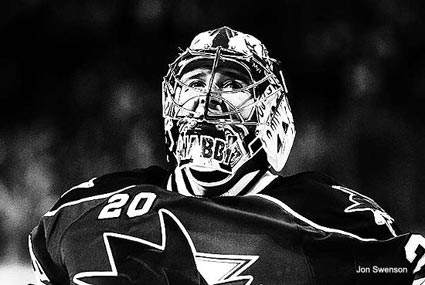Yahoo Puck Daddy’s Mount Puckmore features the four faces of the San Jose Sharks

THE REVERED SAN JOSE SHARKS MOUNT PUCKMORE - B.D. GALLOF
Yahoo’s Puck Daddy blog published my San Jose Sharks version of the hockey Mount Puckmore featuring the four faces of the franchise. Thanks to Sean Leahy and Greg Wyshynski for keeping the hockey discussion going during the offseason. Below is the full unedited version. To offer your thoughts or selections, visit battleofcali.com or this archive post on fearthefin.com. Mount Puckmore image courtesy of B.D. Gallof from hockeyindependent.com.
Mount Puckmore: The four faces of the San Jose Sharks
by Jon Swenson
The San Jose Sharks will celebrate their 20th anniversary in 2010-11. From the inaugural two seasons played at the Cow Palace south of San Francisco, to a recent run that includes a Presidents’ Trophy, 4 Pacific Division Championships, and 6 straight playoff appearances at HP Pavilion in San Jose, the Sharks have created their share of memories and witnessed their share of memorable figures.
Nostalgia almost dictates a referential look back at the Cow Palace years. After being declined as a venue for the NHL’s first go around in Northern California with the Oakland Seals, the former California State Livestock Pavilion served as a temporary home from 1991-93 while the new San Jose Arena was under construction. The Sharks inaugural lineup included former Norris Trophy winning defenseman and current GM Doug Wilson as captain, first-ever 1st round draft pick Pat Falloon (2nd overall to an expansion Sharks team, a non-expansion Quebec Nordiques team unsuccessfully drafted Eric Lindros 1st), fan favorite Kelly Kisio, a cult figure in enforcer Link Gaetz (326 PIMs), starting goaltender Jeff Hackett, and rookie Arturs Irbe among others.
While the first season managed expectations as an expansion team, the second season at the Cow Palace was a test of wills for hockey fans. The Sharks were not just a struggling team, they were bad on a historic scale. In the 93 years since the league was founded in 1917, the 1992-93 San Jose Sharks establised the record for most losses in a season with 71 (84 games played), tied the 74-75 Washington Capitals with a 17-game losing streak, and finished with a -140 goals for/goals against ratio. “While the Sharks can’t find a way to stop the opposition, they are finding new and painful ways to make the record book,” Sports Illustrated’s Austin Murphy wrote in March 1993 after the Sharks gave up 13 straight goals to the Calgary Flames en route to a 13-1 loss. The players had pride and ground through the rest of the schedule. The fans? Many geared up at local pubs before the game resulting in an atmosphere that should make several appearances in Theo Fleury’s as yet unpublished memoirs.
The first two seasons played in San Jose from 1993-95 resulted in back-to-back playoff appearances, and back-to-back first round playoff upsets that literally shocked the NHL. The Sharks knocked off the top-seeded Detroit Red Wings in the first round of the 1993-94 Stanley Cup Playoffs on a Jamie Baker goal in game 7. Fans watching the game at local bars spilled out into the streets like it was a Stanley Cup celebration, possibly unaware there were 3 more playoff rounds to play. One lockout shortened year later, the Sharks knocked off the Calgary Flames in the opening round. Russian greats Igor Larionov and Sergei Makarov paired with Johan Garpenlov, Latvians Arturs Irbe and Sandis “Ozone” Ozolinsh, Ray Whitney, Ulf Dahlen, and a rookie 6-foot-5, 235-pound defenseman Mike Rathje helped the Sharks earn a measure of success in the South Bay that still resonates to this day. In the shadow of championship caliber teams in San Francisco (49ers-5) and Oakland (Raiders-4, Athletics-4, Warriors-1), from the start in San Jose fans had something they could point to in the South Bay.
Nostalgia aside, the 4 faces of the Sharks Mt. Puckmore are all players from the current or not-to-distant era.

SAN JOSE SHARKS FORWARD PATRICK MARLEAU - PHOTO JON SWENSON
Patrick Marleau:
When current San Jose Sharks GM Doug Wilson succeeded former GM Dean Lombardi in 2003, Wilson stressed the desire to ice a young, up-tempo, offensively minded team. Patrick Marleau is the player most responsible for delivering on that promise, and in the process he has become the face of the San Jose Sharks, and for several years running, the face of the Bay Area’s most successful sports franchise.
There are “five tool” players in baseball. 6-foot-2, 225-pound Patrick Marleau is the National Hockey League equivalent. A gifted playmaking center, Marleau moved to the wing alongside Joe Thornton and became an equally adept sniper/power forward. In a contract year, he finished with a career high 44 goals and the second highest point total of his career with 83. Marleau’s work on special teams has been equally impressive, helping the Sharks become the only NHL team to finish top-5 in power play and penalty kill percentage in each of the last two seasons. In that span Marleau has registered 23 power play goals and formed one of the most dangerous pk units in the league along with Joe Pavelski.
Patrick Marleau is the San Jose Sharks franchise leader in games played (953), goals (320), assists (373), points (693), power play goals (97), game winning goals (59), and shots (2194), yet he is often looked at through the sole prism of playoff success, or lack therof. Despite the fact that he leads the NHL with 12 game winning goals in the Stanley Cup Playoffs since 2001, Patrick Marleau and Joe Thornton have born the brunt of criticism after failing to advance to the Stanley Cup Finals after 6 straight opportunities.
In that period, Marleau has been tested. His play against Detroit in the 2007 Western Conference Semifinals was singled out for criticism by the media and head coach Ron Wilson. A year later in Game 3 of the WCQF, a less talented Calgary Flames squad tried to physically eliminate Marleau. Defenseman Dion Phaneuf targeted Marleau’s head with a hit against the glass, one that lead the NHL offseason instructional video sent to each team that summer to reduce the number of headshots. Later in the game Cory Sarich landed a blatant elbow to the head that opened up a cut near Marleau’s eye. Marleau’s response was to put his head down and finish out the series, he did not even miss a shift.
The quiet, reserved aspect to his personality sometimes works against the Aneroid, Saskatchewan native (population 45). When the Sharks changed the captaincy from Marleau to Rob Blake, Marleau was not vocal about the fact that it was not a demotion, or the fact that it would not diminish his desire to win in San Jose. Towards the end of his 2008-09 regular season, he suffered the first major knee injury of his career. The news went almost completely under the radar, to the point where one television reporter asked if it was really an injury, or if he just wanted to spend time with his newborn baby. Marleau laughed at the question, but the knee injury would dramatically impact the Sharks opening round playoff series against Anaheim. Skating at around 60%, looking like a late career Pavel Bure with slow wide turns, Marleau was not effective against the Ducks and his teammates allowed the so-cal rivals to set the tone and tenor of the series.
A year later, Marleau had success against the Detroit Red Wings in the WCSF, and against Chicago in the WCF, but the team as a whole did not raise their game high enough in critical situations. The playoff questions for Patrick Marleau and the Sharks will remain. After signing a 4-year contract extension along with Joe Pavelski in June, the fans in San Jose will have more bites at the playoff apple down the line. BBC Top Gear host Jeremy Clarkson recently said Formula 1 driver Gilles Villeneuve was spectacular on occasion, but Ayrton Senna was spectacular every time he stepped into a car. Marleau is spectacular in the playoffs on many occasions, but for the Sharks to reach the promised land they are going to need him to be spectacular every time he steps on the ice.

SAN JOSE SHARKS CENTER JOE THORNTON - PHOTO JON SWENSON
Joe Thornton:
As a Boston Bruins fan for 12+ years before the San Jose Sharks received a franchise, I can indentify with onslaught of Thornton opinions from fans on both coasts. The trade of Joe Thornton for Marco Sturm, Brad Stuart and Wayne Primeau on November 30th, 2005 may go down as the Wayne Gretzky trade North for its impact on hockey in California. After Thornton’s Art Ross Trophy and a Hart Memorial Trophy campaign in 2005-06, a trip to the local hockey rinks near San Jose would find young boys and girls trying to bank passes off of end boards, hockey nets, coaches, walls, pets, fans standing around the bleachers, bloggers.
“Be Like Joe” would have been a perfect advertising campaign in the model of Air Jordan’s, but around the hockey playing community in the Bay Area it would have rung true. Thornton’s infectious personality, humor, and penchant for doing interviews in as little clothing as possible has not only drawn casual and non-sports fans to Sharks games, it more than likely has kept several teammates playing in Teal.
One NHL front office member said that Joe Thornton is the type of player that you build an offense around. He has the ability to transform a Jonathan Cheechoo into a 56 goal Rocket Richard winner, turn a Patrick Marleau into a 44-goal sniper, help a second year Devin Setoguchi add 20 goals and 48 points to his rookie totals. Thornton does it all while being a genuinely fun player to be around. The playoff questions remain for Thornton as well, and given the seven and a half years he played in Boston, they are not going to go away quietly.
The criticism came to a head after a bitter first round playoff exit to Anaheim in 2009. After winning a Presidents’ Trophy and flirting with historical NHL win totals earlier in the year, the San Jose Sharks came out flat and let Anaheim dictate the pace of the series. The Ducks earned the first two wins on Sharks home ice. San Jose came from behind with a win in game 3, but a blowout loss by four goals put the team behind the 8-ball. Thornton unsuccessfully tried to start a fight with Ryan Getzlaf in game 5, but in game 6 both dropped the gloves for a memorable playoff tussle. Thornton made good use of the short Jody-Shelley jab to pummel his so-cal rival, but it would be the Ducks who would win the game and the series.
Asked by me after the season whether he knew what it took to win in the playoffs after that Anaheim series, Thorton emphatically responded that he did. The next year he helped lead the Sharks to the Western Conference Finals. In a contract year, Thornton could light the league on fire and then roast chipotle fish tacos on top of it. Expectations for #19 will always center around the playoffs, and 2010-11 will be another make or break season. There is not a team in the NHL that would not want to sign him as a UFA a year from now.
Owen Nolan:
There are few players in the NHL that can serve as a team’s leading enforcer and leading goal scorer at the same time. Owen Nolan nearly accomplished that feat for the San Jose Sharks in the 1999-2000 season. Acquired in a trade with Colorado for Sandis Ozolinch in 1995, Nolan finished with a career high 44 goals. He also added 110 PIMs. He may have finished behind Ron Stern (151 PIMs), but Nolan simply dismantled other players on the ice. Irish-born but Canada-raised, when Nolan’s anger was up he skated menacingly around the ice looking to rip players heads off. There was fear evident in opponents heading into the corners against Nolan, and for someone raised on Cam Neely, it was an example of what hockey is all about… hockey played at the highest levels by mean Canadians.
For a goal starved team under head coach Darryl Sutter, Nolan was the go-to scoring option but San Jose saw themselves passed by in the playoffs. Dallas, Colorado and St. Louis passed the Sharks by to the later rounds. Despite grueling, physical playoff battles, the frustration began to build until a rebuild mode was the only option. Nolan was traded at the 2003 deadline for Alyn McCauley, Brad Boyes and a 1st round pick.
It was the end of an era for many Sharks fans.
Nolan authored several of the most memorable moments in Sharks hockey. His called shot goal against Domink Hasek in the 1997 Allstar Game in San Jose, his flying hit against Dallas Stars goaltender Billion dollar Ed Belfour in the 1998 Western Conference Quarterfinals, and his 100 foot slapshot goal against Roman Turek are but a few of his highlights. In February 2001, a flying elbow from Nolan on Grant Marshall drew an 11-game suspension and the ire of NHL disciplinarian Colin Campbell.
As an unrestricted free agent, one has to wonder if the expectations and circumstances for Owen Nolan and the San Jose Sharks could result in a Teal #11 finale. Owen Nolan is the type of player that could throw teammates through walls if they did not skate through it themselves. That might be just what the Sharks need.

FORMER SHARKS GOALIE EVGENI NABOKOV - PHOTO JON SWENSON
Evgeni Nabokov:
Arturs Irbe may be the first goaltender to appear on many best-of lists in San Jose, but for the last 10 years the Sharks have experienced an almost unparalleled (outside of New Jersey) stability in goal. Much of that stability came at the lightning quick glove hand of Evgeni Nabokov.
After a brief 11 game stint in 1999-2000, Nabokov earned the starting reigns after starter Steve Shields was injured early in the 2000-01 season. No one knew at the time that Nabokov would finish out the year with a Calder Trophy, and that he would battle for most of the next decade to retain the starting role in San Jose.
The playoff spotlight that shines down on Patrick Marleau and Joe Thornton, also has to light up Evgeni Nabokov. He helped carry underpowered and rebuilding Sharks teams to the playoffs early in his tenure, and during the peak 6-year Stanley Cup Playoff run he gave the Sharks an opportunity to win every series. The highlight of his Sharks career may have come during a quadruple overtime game 6 of the 2008 WCSF. Battling fellow veteran Marty Turco, Nabokov traded Turco highlight reel save for highlight reel save until late the next morning. The series deciding goal came on the power play, ending the playoff run for a 2007-08 Sharks team that mave have been the most talented in franchise history.
Nabokov signed a 4-year, $24M contract with Ska St. Petersburg a few days after the start of this summer’s free agent frenzy. After averaging 43.6 wins a year over the last three seasons, including backstopping the Sharks to their first Presidents’ Trophy and a runner-up finish for the Vezina Trophy, Nabokov leaves the Sharks as the franchise leader in games played (563), wins (293), saves (13463) and shutouts (50) faced more shots and played more minutes with a San Jose Sharks crest on his jersey (14757, 32492) than the next four goaltenders combined (Irbe, Shields, Vernon and Toskala).
Nabokov has set the standard for a goaltending corps in San Jose that has included himself, Miikka Kiprusoff, Vesa Toskala, Arturs Irbe, Mike Vernon, Steve Shields, Kelly Hrudey, Brian Boucher and Wade Flaherty among others. It will be up to Antero Niittymaki, Thomas Greiss or Alex Stalock to surpass it.
Honorable mentions:
Goaltender Arturs “Like Wall” Irbe (5 seasons) set the mould for a franchise whose perennial strength would be built from the goal out. The 5-foot-8 goalie battled hard in net, and caused fans to hold their breath when he traveled out of the crease to play the puck. In 1993-94, Irbe played 74 games and set a then league record with 4412 minutes played. Former captain and current EVP/GM Doug Wilson was the Sharks first NHL Allstar representative in 1992. Wilson brought credibility, respect and direction to the expansion franchise before retiring. While Sergei Makorov was a former member of the legendary KLM Russian line, and he was more productive in teal, the playmaking Igor Larionov made more players around him better and helped establish hockey in the South Bay with his flamboyant offensive style.
Some players attain a level of success, and maintain that over a period of time to become Allstar or Hall of Fame players in their sport. Right wing Jonathan Cheechoo captured a moment in time. With 56 goals in 2005-06 he earned a Rocket Richard Trophy and helped the Sharks pick up where they left off coming out of a disheartening lockout. Cheechoo’s breakout year actually occurred one season earlier in 2003-04. With Mike Ricci and Scott Thornton feeding him pucks on the third line, Cheechoo scored 28 goals from all areas of the ice, from his knees, and even with a stick between his legs. Injuries, including a double hernia which may have forced him out of San Jose, have slowed Cheechoo down but it was also a product of his hard nosed playing style. In the opening game of the 2008-09 season, Cheechoo helped usher in the net front playing style developed by rookie head coach Todd McLellan. Cheechoo took a pounding in front of the net, but as was his trademark he was hard to knock off his feet and punched home two goals against the Anaheim Ducks. Looking at a stat sheet does not tell you how he played the game, and Cheechoo remains one of the most popular players to ever play for the Sharks in the teams history.
Last on the honorable mention list, but probably first on more than a few lists would be heart and soul center Mike Ricci. Once named the sexiest man in Colorado, and currently a development coach in the Sharks front office, Ricci made his living being a handful for opposing goaltenders and defenseman in front of the net. Unlike a melodramatic Corey Perry who flops anywhere from 15 feet out, Ricci was a bull in a china shop. Arms, sticks, skates and hair would all collapse usually under a pile of bodies around the crease. Ricci became the defacto face of the Sharks in San Jose, and fans and teammates alike rallied around his competitiveness and passion for the game.







 Editor: Jon Swenson
Editor: Jon Swenson Writer: Max Giese
Writer: Max Giese Writer: Darryl Hunt
Writer: Darryl Hunt